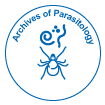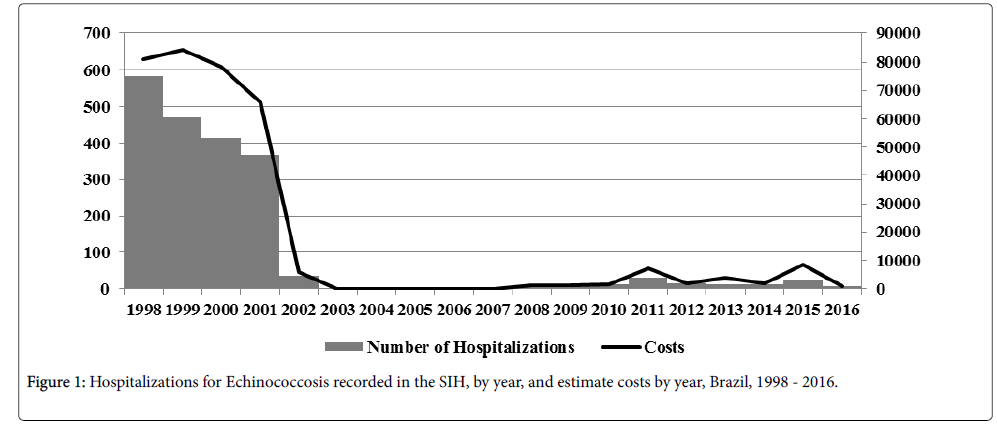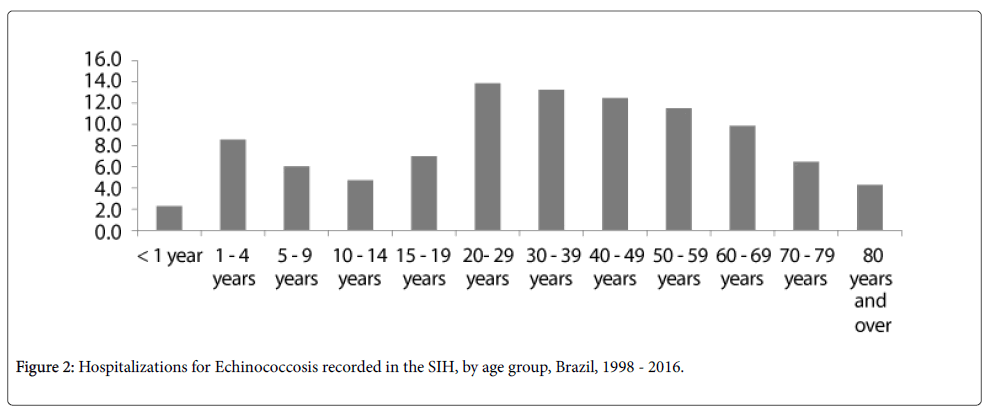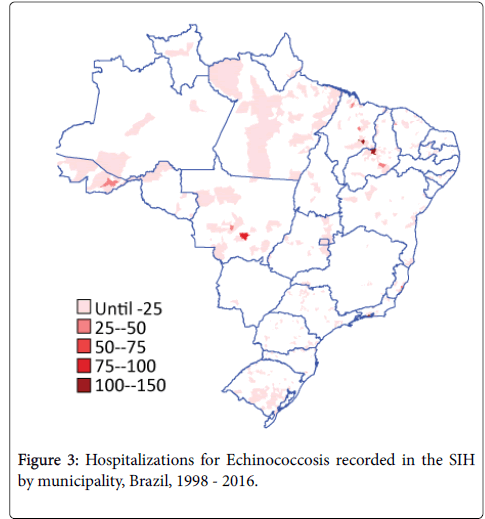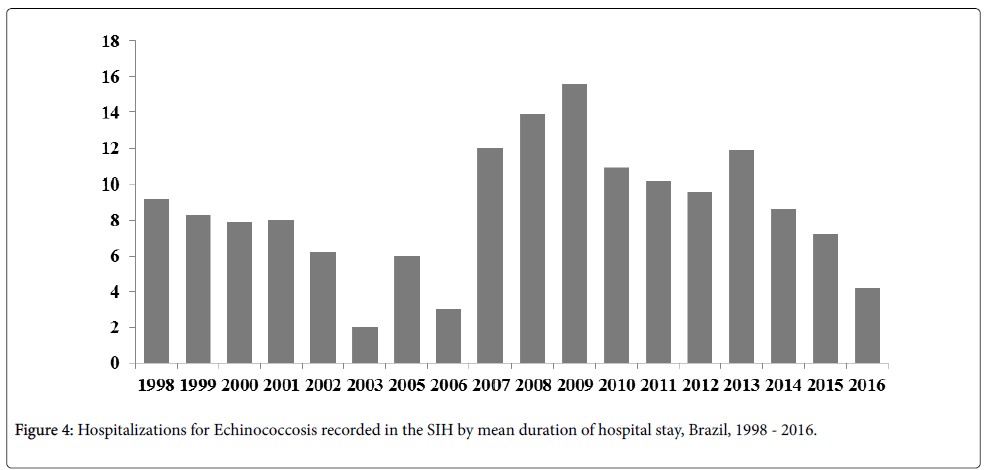Records of Hospitalizations from Echinococcosis in Brazil, 1998-2016
Received: 16-May-2017 / Accepted Date: 01-Jun-2017 / Published Date: 07-Jun-2017
Abstract
Human echinococcosis, also referred to as hydatid disease, is a neglected disease in Brazil and many other countries. Its distribution and hospitalization characteristics are poorly known and so can be little used in the development of public health policy. From January 2000 to December 2015, we recorded national patterns of hospitalization and symptoms using the International Classification of Diseases and estimated the costs of treatment. The number of hospitalizations may have been underestimated due to lack of awareness of health workers of this disease and a resulting inability to identify the disease symptoms and record them accurately in the National Hospitalization Information System.
Keywords: Burden of illness; Cost of illness; Cestodes; Echinococcosis; Health economics; Zoonoses
66433Introduction
Echinococcosis is a zoonosis caused by an intestinal taeniid cestode that lives as a sexual adult in dogs and other canids, and for which there are four different etiologies in humans caused by the asexually proliferative hydatid cyst stages of distinct species: Echinococcus granulosus, E. oligarthrus, E. multilocularis and E. vogeli. The fact that humans are infected only by the hydatid cyst stage is the basis for the alternative name of this infection in humans, referred to as hydatid disease. While only canids harbor the sexual adult tapeworms, other animals besides humans are often hosts for the hydatid cysts. Within the Americas, human echinococcosis is most common in South America, but it also occurs in the Mediterranean and Middle East. [1,2].
Echinococcosis has been considered by the World Health Organization (WHO) as a neglected tropical disease since 2013 [3]. It persists since the parasitic cycle occurs not only in domestic animals, but also in wild ones, where the infestation cannot be properly controlled [2].
In Argentina, Brazil, Chile and Uruguay, it is estimated that this disease was responsible for more that 300,000 days of hospital internment between 2009 and 2014 [4-6].
The impact of echinococcosis on the health of local human population is sufficiently severe that the WHO officially declared ehinococcosis as a disease to be eliminated by the year 2020. Part of the action plan for this project includes a study of the effectiveness of national control and prevention programs and a study of priority activities in pilot areas [7].
In Brazil, echinococcosis occurs mainly in the south where it mostly affects rural workers along the border with Uruguay and Argentina. In the north, it is commonest in the states of Acre and Pará. In the south the etiological agent is Echinococcus granulosus, while in the north E. vogeli is most prevalent [6]. Currently, this disease is not included in the Ministry of Health Ordinance that defines the diseases, injuries and public health events present on the National List of Compulsory Notification for public and private health services throughout the national territory [8].
Accordingly, the use of other Health Information Systems to obtain information regarding this disease has become an important tool for identifying the national epidemiological profile of echinococcosis.
Among the different hospital-based recording systems in Brazil, the SIH (Sistema de Informações Hospitalares) identifies records of hospitalization according to demographics, cause, hospital stay length, geographic distribution, and costs.
Dissemination of data on echinococcosis is still scarce in Brazil, both in the national and worldwide literature. The current paper presents data on echinococcosis-related hospital admissions in order to provide information on the direct financial impact of such hospital admissions, foster technical discussions and improve public policies for the control and prevention of human cases of this disease.
Materials and Methods
A broad-based retrospective study was carried out using hospital admission data from January 1999 to September 2016, using the Brazilian Ministry of Health’s Hospital Information System data base (SIH: derived from the acronym for Sistema de Informações Hospitalares).
SIH was developed to manage financial transfers to those hospitals either in the Brazilian public health sector or contracted to it. The system covers more than 80% of all Health Units in Brazil, and uses the Hospitalization Internment Authorization (AIH: Autorização de Internação Hospitalar) system as the information source. It does not, however, record epidemiological data.
The Brazilian Unified Health System (SUS: Sistema Único de Saúde) provides for disease prevention, as well as treatment and rehabilitation of patients. It is a universal and integral system, and provides care, medication and rehabilitation to all Brazilians, whenever necessary, without any direct financial burden on the population.
To select the information to be used in the current study, we chose those records from the International Classification of Diseases (ICD-10) that gave echinococcosis and its derivations as the primary cause of hospitalization. Records were identified as follows:
B67 Echinococcosis
B67.0 Hepatic infestation by Echinococcus granulosus
B67.1 Pulmonary infestation by Echinococcus granulosus
B67.2 Bone infestation by Echinococcus granulosus
B67.3 Infestation by Echinococcus granulosus , other and multiple locations
B67.4 Unspecified infestation by Echinococcus granulosus
B67.5 Hepatic infestation by Echinococcus multilocularis
B67.6 Infestation by Echinococcus multilocularis , other and multiple locations
B67.7 Unspecified infestation by Echinococcus multilocularis
B67.8 Hepatic infestation by unspecified Echinococcus
B67.9 Infestation by Echinococcus, other and multiple locations
Information was classified according to demographic data such as sex and age, and with hospital care including temporal patterning of hospitilization, length of stay, mortality rate and costs.
Costs were calculated using to the number of hospitalizations plus total and average cost paid for hospitalization using a dollar value corresponding to $US 1=R$ 3.12 (as on March 28, 2017).
Death rate was calculated as the ratio between the number of deaths and the number of AIH patients registered as hospitalized, during the study period, multiplied by 100 [9].
Data analysis was conducted using the following software: Freeware Tabwin 32b and Microsoft Office XP®.
The study was carried out using secondary data. Following the Resolution of the National Health Council 510/2016, data were treated collectively in an analysis that did not access name-based information or any other data form that could identify individuals [10].
Results
A total of 2,006 echinococcosis-related hospitalizations were identified between 1998 and 2016. The highest number of hospitalizations was recorded at the beginning of the study series, between 1998 and 2001. After this the number of hospitalizations decreased, declining to just one record in 2003 and no records for 2004. In 2016 (up until the month of August) six such hospitalizations were recorded (Figure 1).
Female records were the most prevalent (1,030 hospitilizations: 51.3% of total records). The most affected age-group was that between 20 and 29 years (278 records: 13.9%), with the second most affected age-group being 30 to 39 years (265 records: 13.2%). Were found 45 records in children under one year (2.2% of the total) (Figure 2).
The SIH contained hospitalization records for echinococcosis from 26 Federal Units in Brazil. The state of Maranhão had the highest number of records (323:16.1%), followed by Piauí (243:12.1%), Mato Grosso (208:10.4%), and Rio Grande do Sul (189:9.4%).
The federal unit with the lowest number of notifications was Amapá, with a single record. In total 10 (0.5%) records were from people residing in other countries or with unrecorded residence locations.
Region-by-region analysis showed the Northeast had 839 hospitalization records (41.8% of total), followed by the Southeast with 369 records (18.4%). The Southern Region had 292 records (14.5%), the North had 249 records (12.4%), and Central West had 247 records (12.3%).
Of the 442 municipalities for which the SIH recorded echinococcosis-related hospitaliations, 30% came from just six localities: Floriano/PI 144 (7,2%), Rio de Janeiro/RJ 113 (5.6%), Colinas/MA 109 (5.4%), Canoas/RS 78 (3.9%), Chapada dos Guimarães/MT 77 (3.8%), Santo Antônio dos Lopes/CE 47 (2.3%), and Croatá/CE 41 (2.0%).
When the spatial distribution of records was analysed, all regions within Brazil had cases. Sergipe was the only state not to register echinococcosis-related hospitalizations (Figure 3).
The number of days of patient hospitalization totaled 17,041, and ranged from 5,385 in 1998 to 2 in 2003. In 2004 the SIH had no records of hospitalization due to echinococcosis, while the period between 2003 and 2007 had the lowest number of hospitalizations (2, 6, 6 and 24, respectively). However, by September 2016, 26 hospitalization days had already been recorded.
Mean number of hospitalization days at the beginning of the study series was 9.2 in 1998, declining to 2.0 in 2003, peaking at 15.6 days in 2009, before falling back again after this. In 2016, mean internment duration was 4.2 days, the third lowest annual average, with only 2003 and 2006 being lower (2.0 and 3.0, respectively) (Figure 4).
Among registered hospitalizations were 29 deaths. The number of annual deaths ranged from one to seven over the study period. The highest number of deaths occurred in 2001 (24.1%), and the lowest in 2002 (3.4%). Hospital mortality rates ranged from 0.86/100,000 hospitalizations in 1998 to 13.33/100,000 in 2012.
The cost of hospitalizations totalled approximately USD 344,000. Hospitalization costs were highest in 1999 (USD 84,221.86), and lowest in 2005 (USD 12.94). Expenditure for both 1998 and 2001 exceeded USD 65,000, after which there was a fall in the year 2002 (USD 18,000). Between 2003 and 2007 the total cost did not exceed USD 30, and then between 2008 and 2016, the values rose again, but did not surpass USD 9,000 (Figure 1). For the years studied, the mean annual hospitalization cost was USD 171.40.
Discussion
Echinococcosis is endemic in all Brazilian regions, yet great difficulties exist in estimating the total costs and occurrence levels by state and municipality. That the disease is not included on the Ministry of Health’s compulsory notification list makes it difficult to analyze with any high degree of certainty the disease’s true distribution, and epidemiological profile or to estimate the true levels of public expenditure devoted to treating this disease. Nor is it possible to estimate the overall prevalence of the disease [8].
Currently, only one Brazilian state, Rio Grande do Sul, has compulsory notification for this disease (established by state decree in 2010) [11]. In the other federal units neither surveillance nor notification systems are in place. This greatly complicates the recording and evaluation of the magnitude of the problem, and exacerbates underreporting of the disease.
The same problem has already been found in other countries, such as Spain, where the lack of a notification system has also led to a lack of registration and underreporting of echinococcosis [12]. The lack of information systems to record cases of echinococcosis gives rise to a false sense that this disease does not have a significant impact on either public health or on treatment costs. However, published studies provide data that, even though it is underestimating the situation, infer a high morbidity in economically-active individuals and high treatment costs [12-17].
The studies above used other information systems and data sources outside of human health area, including animal health, in order to measure this zoonosis impacts. This study is limited by the use of the SIH data, which only includes hospitalizations for CE, by this way we consider that the data presented may be underestimated when compared with those. From this perspective, we identified the need for future studies that include other sources of information in Brazil.
Studies that estimate the actual number of existing cases give the disease an even more extensive range: a study in Brazilian Amazonia between 1962 and 2003 described 40 cases of human echinococcosis, 39 in Pará and one in Amapá [18]. In this study it was not possible to identify the presence of E. vogeli in the SIH database among the etiological agents that cause the disease, since the ICD for E. vogeli is not available in this system.
Equinococcosis: Argentina, Brazil, Chile, Peru and Uruguay’’ (Iniciativa para el control de la Equinococosis quística: Argentina, Brasil, Chile, Perú y Uruguay) indicates that, in the period from 2009 to 2014, a total of 29,000 cases of echinococcosis were reported in these five countries. Of these countries, Brazil had 91 confirmed cases, the lowest prevalence, with the highest being in Peru (20,785) [6].
Worldwide it is estimated that more than one million people are infested by this parasites in its hydatic cystform, and more than 1 million people are affected with echinococcosis at any one time [2].
Such studies support the data presented in this study, highlighting the difficulty in confirming cases and supporting the need for additional studies that cover the entire national territory. This study brings together data from all national SIH data bases and may be considered one of the first to show the distribution and prevalence of echinococcosis and indicate the true seriousness of the disease.
Comparing the findings of the current study with those from other information systems may facilitate mapping of the disease and allow better characterization of its magnitude and epidemiological profile. It should be noted that there is a possibility of readmission of the same patient to hospitals in the system: this would increase the number of patients, but cost data values and the care profile would be unchanged.
Reasons for the decrease in the number of hospitalizations after 2001 is currently uncertain: it may indicate that there has been a change in the criteria for notification of hospitalizations or that other diseases whose hospital treatments cost more than echinococcosis are being reported in its stead, causing the subnotification.
Certainly, there were no changes in diagnostic methods that could explain such a decline in the recorded number of echinococcosisrelated hospitalizations and their continuing stabilization in Brazil at very low rates. Possibly the only reason that can justify this fact is the change of registry codifications and the low value paid by the government for each hospitalizations of this disease.
That most patients are within the economically active age range reflects the fact that this disease may be related to the work environment and so is an occupational hazard and should be treated and prevented as such [19].
The most commonly affected age group was between 20 and 39 years old (27.1%). However, children under 15 years old totalled 21.5%, of which 45 were under one year old (2.2% of the total). The large number of records from children under 15 years reflects the persistence of infestation in the environment and a lack of effective treatment of parasite-infested animals [2].
Cases have been recorded in all regions of Brazil, although a definitive etiology of the agent involved has yet to be reported. One cause may be the increase in recent years in the movement of domestic animals between the various regions of the country. Despite being the only federated unit with mandatory notification of human echinococcosis, Rio Grande do Sul ranked fourth for recorded hospital admissions, which may be associated with early identification of suspected cases. Patients from other countries may have sought treatment in Brazil, as happens with other diseases such as tuberculosis, due to the Brazilian SUS providing universal and comprehensive care [20].
Brazil has 5,670 municipalities, of which hospitalizations with this disease were recorded for 442 (7.9%). The localities concerned are distributed widely throughout the country. This increases the need for a surveillance system that allows cases to be identified and the magnitude of the problem to be determined, so that the necessary measures of effective control and prevention can be implemented.
The SIH was developed for the management of financial resources and not for epidemiological purposes, but provides information on the costs related to the diseases that are directly related to the International Classification of Diseases and procedures. In doing so, it deploys the clinical classifications of the SIH system. Consequently, it can be considered as a viable means of gaining information on those cases of echinococcosis whose severity has led to their diagnosis, although under-reporting of cases is still very likely.
It is assumed that this disease has been reported in the SIH system only in those cases where the primary cause of hospitalization was related to echinococcosis. Consequently, it is likley that hospitalizations when this disease was a secondary or tertiary cause were not accounted for.
The SIH covers more than 80% of the national hospital network and reaches the largest portion of the Brazilian population. However, records of extra-hospital care, such as outpatient services, are not covered by the System, so that the national incidence of cases is likely to be underestimated in the current survey.
The SIH records only those patients who sought medical help and were hospitalized. As a result, the system can only record the most serious cases. This makes it difficult to effectively estimate the actual number of cases. However, since the SUS is a universal and integral system, it is probable that most of the cases identified will be attended at outpatient units and will be relocated to hospital care when this level of care is required. Therefore, we consider the SIH a representative register of serious cases and a valuable source of information about the state of health in Brazil. While the Information System alone cannot be used to identify the epidemiological profile of echinococcosis in Brazil, it is possible, however, to affirm that this is both a neglected and an important disease that can disrupt work activities substantially, especially in the economically active age group.
There is a need to implement a system of prevention and control of the disease, including its compulsory notification, as occurs with other zoonoses such as rabies, leishmaniasis and others that are present on the current compulsory notification list [8].
The data reveal that the disease is present in almost all areas of Brazilian territory; with the exception of Sergipe State, all federated units recorded at least one echinococcosis-related hospitalization of a resident person during the study period. The predominance of the economically active age group underscores the need for a routine early evaluation by the health services of parasite exposure in high-risk groups, such as rural area populations and sheperds who use dogs on their farms.
Although the data structure meant this study could not identify disease exposure characteristics, the available literature indicates that most infections occur in rural areas and therefore monitoring potentially infested properties and the human population living or working there would be a good starting point from which to monitor and aid the primarily affected population.
Direct costs illustrate the need to carry out measures to control infestation or block the epidemiological chain. This will reduce or avoid the expenses associated with hospitalization and the treatment of severe forms of the disease, allowing care capacity to be used for other diseases that are more prevalent within Brazil [15-21].
References
- McManus DP, Zhang W, Li J, Bartley PB (2003) Echinococcosis. Lancet 362: 1295-1304.
- Eckert J, Deplazes P (2004) Biological, epidemiological, and clinical aspects of echinococcosis, a zoonosis of increasing concern. Clin Microbiol Rev 17: 107-135.
- World Health Organisation (2013) Resolutions and decisions: WHA66.12 Neglected tropical diseases. Geneva: World Health Organization.
- Larrieu E, Zanini F (2012) Critical analysis of cystic echinococcosis control programs and praziquantel use in South America, 1974-2010. Rev Panam Salud Publica 31: 81-87.
- Moro P, Schantz PM (2006) Cystic echinococcosis in the Americas. Parasitol Int 55: S181-S186.
- Centro Panamericano de Fiebre Aftosa (2015) Informe Epidemiológico en la Región de América del Sur - 2009-2014. Informe Equinococosis - Nº 1 - Septiembre de 2015.
- World Health Organisation (2016) Meeting of the WHO Informal Working Group on Echinococcosis (WHO-IWGE), Geneva, Switzerland, 15-16.
- Portaria n° 204, de 17 de fevereiro de (2016) Gabinete do Ministro/Ministério da Saúde. Define a Lista Nacional de Notificação Compulsória de doenças, agravos e eventos de saúde pública nos serviços de saúde públicos e privados em todo o território nacional, nos termos do anexo, e dá outras providências.
- Departamento de Informática do SUS. DATASUS (2008) Morbidade Hospitalar do SUS por local de residência – a partir de 2008 Notas Técnicas.
- Ministério da Saúde do Brasil, Conselho Nacional de Saúde (2012) Resolução N° 466, de 12 de dezembro de 2012. Aprovar as seguintes diretrizes e normas regulamentadoras de pesquisas envolvendo seres humanos.
- Governo do Estado do Rio Grande do Sul, Portaria Nº 203/2010 de 24 de Março de 2010. Estabelecer a notificação compulsória de casos de Hidatidose humana, no Rio Grande do Sul.
- Benner C, Carabin H, Sanchez-Serrano LP, Budke CM, Carmena D (2010) Analysis of the economic impact of cystic echinococcosis in Spain. Bull World Health Organ 88: 49-57.
- Torgerson PR (2003) Economic effects of echinococcosis. Acta Trop 85: 113-118.
- Budke CM, Jiamin Q, Qian W, Torgerson PR (2005) Economic effects of echinococcosis in a disease-endemic region of the Tibetan Plateau. Am J Trop Med Hyg 73: 2-10.
- Moro PL, Budke CM, Schantz PM, Vasquez J, Santivanez SJ, et al. (2011) Economic impact of cystic echinococcosis in Peru. PLoS Negl Trop Dis 5: e1179.
- Torgerson PR, Carmona C, Bonifacino R (2000) Estimating the economic effects of cystic echinococcosis: Uruguay, a developing country with upper-middle income. Ann Trop Med Parasitol 94: 703-713.
- Budke CM, Deplazes P, Torgerson PR (2006) Global socioeconomic impact of cystic echinococcosis. Emerg Infect Dis 12: 296-303.
- Soares MC, Moreira-Silva CA, Alves MM, Nunes HM, Amaral IA, et al. (2004) Polycystic echinococcosis in the Eastern Brazilian Amazon: an update. Rev Soc Bras Med Trop 37: 75-83.
- Youssefi MR, Mirshafiei S, Moshfegh Z, Soleymani N, Rahimi MTJ (2006) Cystic echinococcosis is an occupational disease? Parasit Dis 40: 586-590.
- Kloetzel K, Pereira JAA (1992) Human hydatidosis in the State of Rio Grande do Sul (Brazil): an estimate of its impact upon public health in the country. Rev Inst Med Trop de SP 34: 549-555.
- Liese BH, Schubert L (2009) Official development assistance for health–how neglected are neglected tropical diseases? An analysis of health financing. Int Health 1: 141-147.
Citation: Lise MLZ, Lise CRZ, de Oliveira SV, de Caldas EP (2017) Records of Hospitalizations from Echinococcosis in Brazil, 1998-2016. Arch Parasitol 1:106.
Copyright: © 2017 Zini Lise ML, et al. This is an open-access article distributed under the terms of the Creative Commons Attribution License, which permits unrestricted use, distribution, and reproduction in any medium, provided the original author and source are credited.
Select your language of interest to view the total content in your interested language
Share This Article
Open Access Journals
Article Usage
- Total views: 3692
- [From(publication date): 0-2017 - Aug 29, 2025]
- Breakdown by view type
- HTML page views: 2729
- PDF downloads: 963
